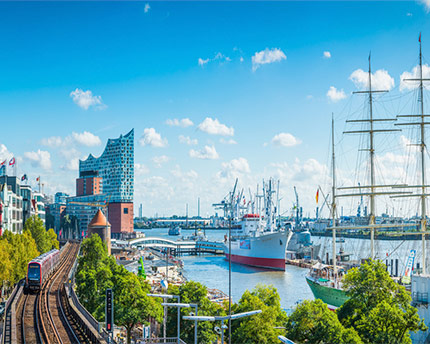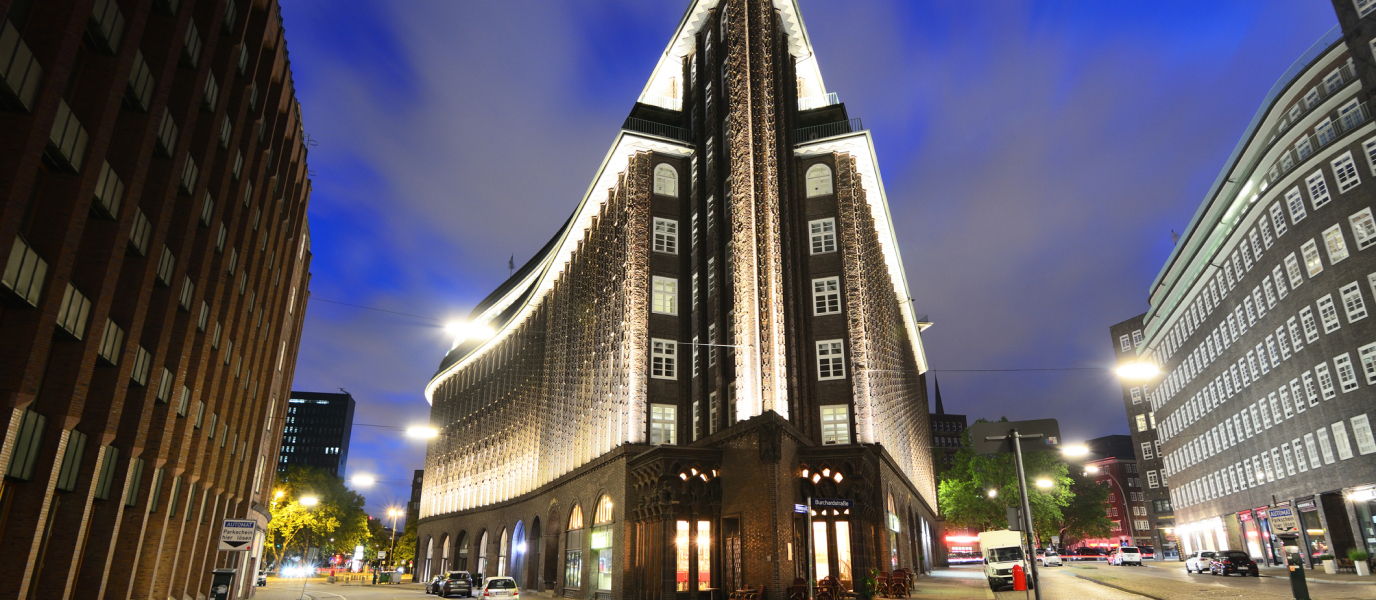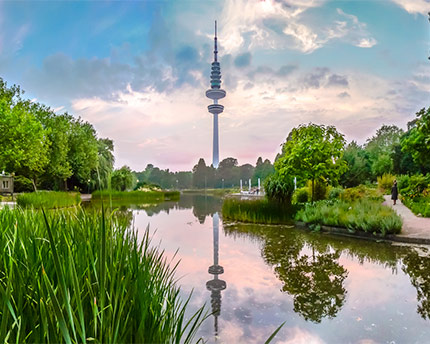Seville has the Guadalquivir, Rotterdam and Antwerp the Meuse and the Scheldt, Bordeaux the Garonne, Lisbon the Tagus, while Hamburg’s great inland waterway is the river Elbe. Almost 100 kilometres separate this German city from the North Sea, yet the Port of Hamburg has always been one of the main European ports and a real gateway to the world.
Today, the Port of Hamburg is not only the second largest in Europe (only behind Rotterdam), it is also an exciting place where you can explore and enjoy the exciting history of this former Free Imperial City and a key part of the powerful Hanseatic League, and where you can experience, on a daily basis, all types of artistic, cultural, gastronomic, sporting and leisure expressions and activities. In short, it is a truly effervescent place that is, of course, well worth a visit.
- The Port of Hamburg, a constantly evolving history
- River Elbe, a global connection
- Fischmarkt, the bustling Sunday market
- Landungsbrücken, the floating dock
- Alter Elbtunnel, an underwater walkway
- Much more than just a port: museums, exhibitions, music, etc.
- Where to eat in Hamburg
- Where to stay in Hamburg
The Port of Hamburg, a constantly evolving history
The history of Hamburg is the history of its enormous port; the two are one and the same. In any case, it can be said in more or less formal terms that the Port of Hamburg was ‘founded’ on 7 May 1189 by Frederick I, Holy Roman Emperor. Since then, this small enclave upriver has been able to take advantage of the deep waters of the river Elbe to become one of the main ports in the history of Europe and a key player in global trade.
In the times of the powerful Hanseatic League (13th to 16th centuries), the Port of Hamburg did nothing more than gain in importance, and the first connections with the newly discovered lands of America established it as the main port in Germany. It is no coincidence that, for example, the famous Hamburg America Line was the world’s largest shipping company in the late 19th and early 20th century.
Today, Hamburg’s large port system, with hundreds of docks and quays, covers more than 70 square kilometres, most of which is on the most industrialised south bank of the Elbe. However, it is the north bank that has the most attractions of historical value, including gems such as the Speicherstadt (literally ‘Warehouse City’), a large area of docks and port warehouses – in fact, the largest of its kind in the world – built in the late 19th century and declared a UNESCO World Heritage Site in 2015.
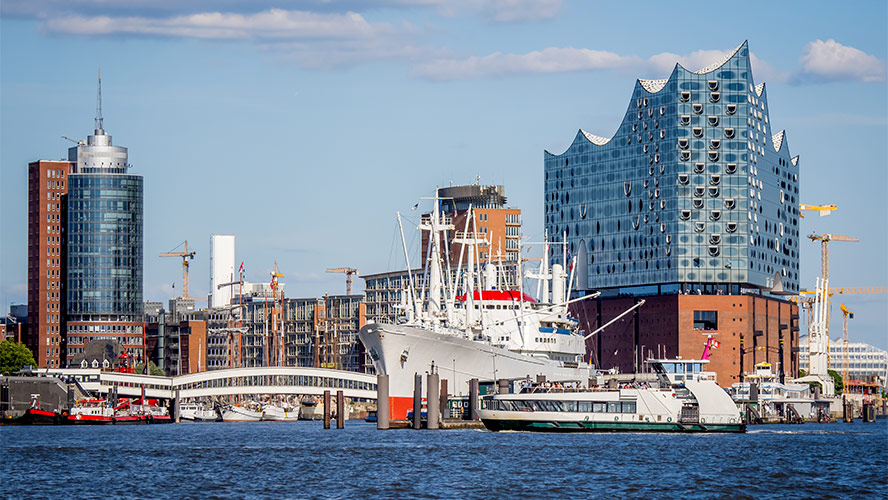
River Elbe, a global connection
A handful of major European rivers have, since time immemorial, linked major cities more or less distant from the coast to the sea and, therefore, to the rest of the world, giving them a global relevance that they would hardly have if it were not for their rivers. The case of the river Elbe and the city of Hamburg is, of course, paradigmatic.
This unique ‘blue waterway’ is the raison d’être of the Port of Hamburg, but it is much more than that. On its waters and banks you can enjoy all kinds of experiences, from pleasant boat trips to exploring the surroundings to visit places such as Elbe beach, a real summer hotspot in the city; the ‘museum harbour’ of Oevelgönne, which shelters a score of historic boats; the various restaurants and cafés which offer the best local cuisine and a breathtaking view of the river itself; and many other historical and natural wonders that give the Elbe a whole range of possibilities.
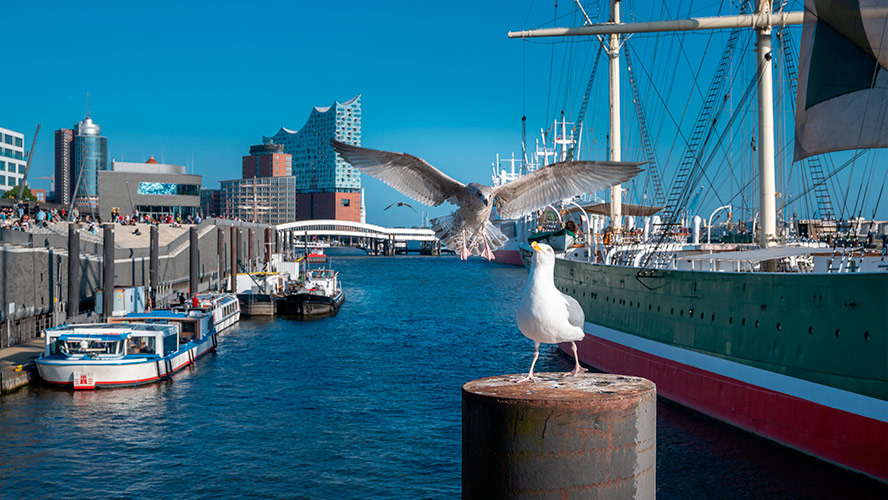
Fischmarkt, the bustling Sunday market
As far as the main attractions of the Port of Hamburg are concerned, history has a lot to say. Clear proof of this is the Fischmarkt, Hamburg’s fish market (internal link to Fischmarkt), which has been held on the banks of the Elbe since 1703.
Every Sunday morning (from 5 to 9:30 a.m. in summer and from 7:00 to 9:30 a.m. in winter), the hustle and bustle take over the esplanades next to the old Altona fish market and, like town criers, the shopkeepers cheerfully shout out the goodness of their products: fruit, vegetables, spices, clothes, souvenirs and, of course, fish. As the decibels get louder, so do the customers!
But not only that, the Fischmarkt has also become a unique meeting point for night owls and early risers; the latter come to their Sunday rendezvous to buy the week’s provisions and the former end Saturday night – many come from the nearby Reeperbahn ‘party district’ – with a typical fish sandwich and a coffee, enjoying the view of the river and the port…. Except for those who go into the old fish market to enjoy the live music performances, the food and the last pint… or the first one of the day! One last dance before heading home.
Landungsbrücken, the floating dock
One of the most iconic places in the Port of Hamburg is this large, 700-metre-long floating dock and the historic buildings that flank it. Located in the eclectic St. Pauli district, its first pontoons were installed in 1839 and their task was to keep the ‘explosive’ steamships (fire in their boilers was always a threat) away from the port itself. In fact, Landungsbrücken literally means ‘landing bridges’, i.e. bridges that linked the terminal buildings and warehouses to the ships moored at the floating docks on the Elbe.
Today, the Landungsbrücken in St. Pauli are still one of the main links in Hamburg’s transport network, both on the river and on land, as well as an unmissable tourist attraction with a wide range of gastronomic, cultural and leisure offerings of all kinds. Buses, trains and underground lines meet here with ferries, catamarans and other boats plying the waters of the Elbe towards the south bank or on attractive trips along the port and the river itself. Moreover, from this very quay depart the boats that carry the audiences of the famous musicals The Lion King and Frozen, which take place in the spectacular port theatres (Theater im Hafen) on the southern shore.
Alter Elbtunnel, an underwater walkway
Right next to the Landungsbrücken, a tunnel was built in 1911 under the waters of the river Elbe. The intention of this technical feat at the time was, of course, to facilitate the connection between the two shores and thereby allow dock workers a direct means of access to their jobs.
With 426 metres of walkway, extending some 24 metres below the surface of the river, the old Elbtunnel was not only a practical solution for urban connection, it also became a symbol of Hamburg thanks to its unique Art Deco style.
Nowadays, communications between the two banks are many and varied: the ‘new’ Elbtunnel, bridges, ferries and underground line make it possible to go from one side to the other without any complications. However, the old tunnel is still a good way to cross the river (free for pedestrians and cyclists, 24 hrs) to explore the south bank since it is a photographer’s dream. In addition, the views of the city from the observation deck at the south exit of the tunnel are absolutely spectacular.
Much more than just a port: museums, exhibitions, music, etc.
In addition to its historical gems, huge cranes, large cargo ships and impressive sightseeing cruise liners, the Port of Hamburg is also a real spectacle, literally. This area of the city offers all kinds of artistic and cultural proposals, from world-class museums and exhibitions to concerts and festivals that are more than attractive.
In that respect, the collection of museums at the Port of Hamburg is really interesting, with places such as the Miniatur Wunderland, the world’s largest miniature model railway; the International Maritime Museum, one of the most impressive collections of nautical artefacts; the Ballinstadt – Emigration Museum, which tells the story of the millions of Europeans who left for the New World in search of a better life; the Discovery Dock, a unique immersive and interactive experience showing the inner workings of the port of Hamburg; and the museum ships Rickmer Rickmers, Cap San Diego and the Soviet submarine U-434… Plus, of course, the old Alter Elbtunnel and the Speicherstadt, among many others.
Likewise, the port area’s artistic and cultural agenda is also one of its great attractions, including major festivals such as Elbjazz, MS Dockville and the Harbour Front literary festival, and undisputed stars like the Elbphilharmonie, as well as the famous and multitudinous Hamburg Harbour Anniversary Festivities (Hafengeburtstag), and the countless live performances at cafés, bars and venues of all kinds (the Sunday morning concerts at the Fischmarkt are a good example).
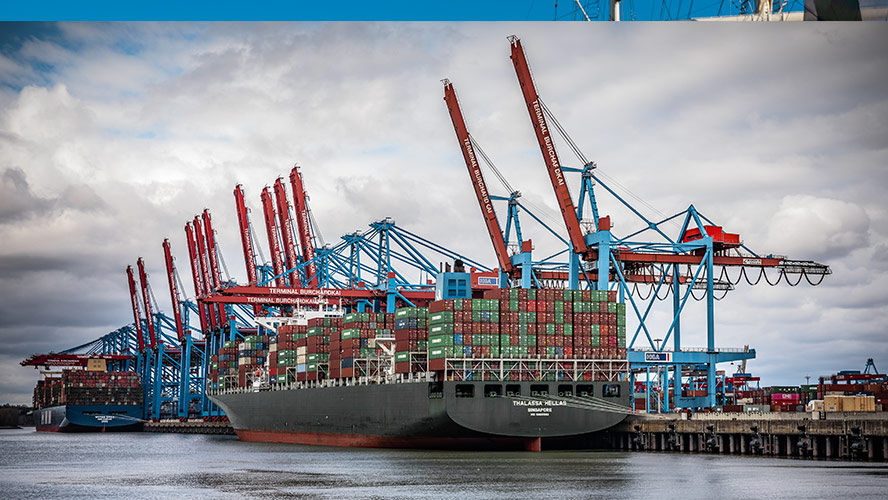
Where to eat in Hamburg
Among the port’s countless offerings, gastronomy also plays a fundamental role, highlighting the area’s eclectic and cosmopolitan spirit. For example, you can enjoy the best haute cuisine at the restaurants of the modern HafenCity such as Stricker’s Kehr Wieder Spitze, with its breathtaking view of the Elbphilharmonie and the harbour itself, and The Table Kevin Fehling, with an innovative 3-Michelin-starred offering.
Of course, it is not all sophistication and luxury at the Port of Hamburg; you can also enjoy the great ‘classics’ of the Deichstraße such as Deichgraf and Gaststätte Zum Brandanfang. The surroundings of the Speicherstadt offer everything from the sophisticated, such as the VLET in der Speicherstadt, to cosy cafés such as Barrossa and Fleetschlösschen by Daniel Wischer. The charm of the Portuguese quarter (Portugiesenviertel) and the eclecticism of St. Pauli cannot be overlooked either; in the former you can eat the best fish at Caramba Especial and Olá Lisboa; in the latter, next to the Landungsbrücken, there are options such as Brücke 10 and its great fish sandwiches, the BLOCKBRÄU brewery and even the Hard Rock Hamburg, among many others. The Fischerhaus, behind the Fischmarkt, is a classic in the area. The options are many and varied; all you have to do is sharpen your sense of smell and let yourself be surprised by Hamburg’s dishes.
Where to stay in Hamburg
Located just over a kilometre from the port and surrounded by some of the city’s main attractions, such as the town hall and the Alster Lake, the Barceló Hamburg hotel (https://www.barcelo.com/es-es/barcelo-hamburg) is an excellent choice for a memorable stay in the city. With 193 fully equipped rooms, this urban and avant-garde 4-star hotel is ideal for both leisure and business travellers. In addition, the hotel has an excellent food offering, headed by its 1700 restaurant and winery.
























































